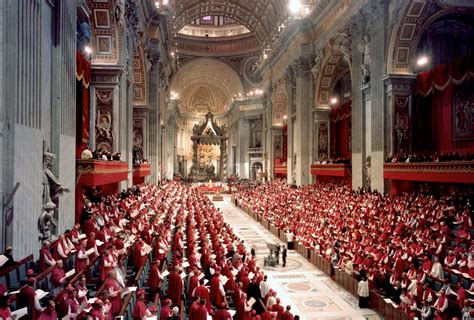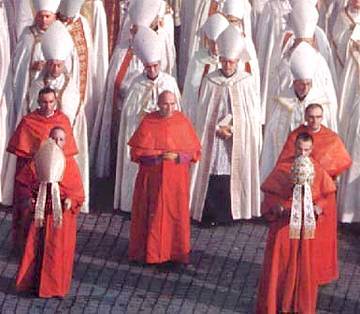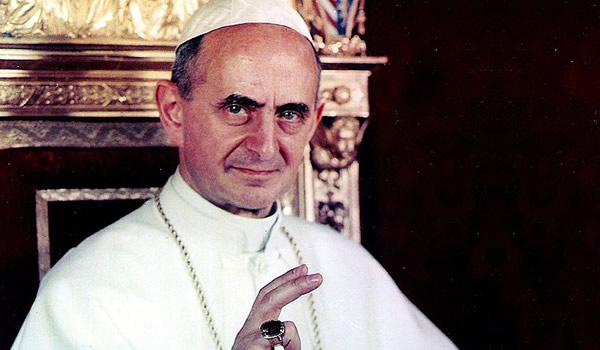
In 1869-70 Pope Pius IX convened the Vatican I Council for the purpose of securing papal infallibility. A century later in 1962-65 Vatican II was convened not to announce the death of this infallibility, nor the death of religious narcissism or the end of the absolute truth that of necessity underpins them, but to inaugurate the re-founding of the Catholic faith, through a re-founding of Christianity as a whole – and consequently a re-founding of Judaism and Islam too.
THIS WAS THE TRANSFORMATION from a paradigm of the sovereignty of the divine intellect – predominating in the Middle Ages – to a paradigm of the sovereignty of the human intellect – initiated with the appearance of humanist philosophy and the philosophy of the Enlightenment.
The watchword employed by Pope John XXII was aggiornamento [the adjustment of religion according to the facts of the world it lives in], that is, an adjustment to “freedom, secularism and democracy.” In much the same way [Turkish Prime Minister] Erdoğan formulated an aggiornamento specifically to Islam, when he presented it to the Muslim Brotherhood and the Nahda Party on his visits to Egypt and Tunisia in 2011. Unfortunately, as was only to be expected from the leadership of the Islamic far right, they turned it down.
A full 2,540 religious leaders, in addition to 40 observers representing all the non-Catholic churches, participated in this Vatican II Council. In the Council’s first round which lasted for more than two months, two currents were confronted. As in all momentous historical events one current stood in opposition to the other: a conservative current and a modernizing current. It was the latter that came out the victor in the second round of the Council (1965).
Islam is also in need of a historic re-foundation to liberate it from its fossilised vocabulary and behaviour
The day following the conclusion of Vatican II the French head of the Conservatives, Msgr Lefebvre, announced the establishment of a schismatic church: the Traditionalist Church which today is in the process of disintegrating with most of its adherents returning to the Vatican fold.[1]
The conclusions which Vatican II arrived at gained the approval of the Orthodox faith, of Anglicanism and Judaism. This became clear in telegrams of congratulations which Pope Paul VI received from the Chief Rabbi of Israel, the Patriarch of the Russian Orthodox Church and the head of the Anglican Church. But it appears that the Shaykh of Al-Azhar was among those conspicuous by their absence!
It appears from the Council’s declarations that most of the Orthodox metropolitan bishops who engaged in the discussions over a period of four years were happy with the values of humanist philosophy and the philosophy of the Enlightenment, values embodied in the 1948 Universal Declaration of Human Rights. Under its guidance they went on to re-found their faiths to such an extent that one of the cardinals described Vatican II as the [Church’s] “Revolution of ‘89”. Hegel famously referred to the year 1789 that it was a ‘philosophy revolution’, that is, the rationalist philosophy of the Enlightenment. It is also well known that the Vatican warred against this revolution and remained hostile to it right up to the date of the convening of Vatican II.
There is no law against dreaming. Let me then dream about a World Islamic Conference convened by his eminence the Shaykh of Al-Azhar Dr. Ahmad Tayyib, to achieve for Islam what Vatican II achieved for Christianity and to embody Erdoğan’s proposal of “the necessity of Islam’s reconciliation with freedom, secularism and democracy”. And I hope that starting from now such a World Islamic Conference will form a committee of experts, from all Islamic sects, tasked with studying the Vatican II documents (2000 pages) for the purpose of deriving useful lessons for this hoped-for conference. I hope that it invites representatives of Judaism and Christianity in Muslim lands as participants, as well as representatives of global Judaism and Christianity as observers. It will thus constitute a renewal and at the same time a re-establishment of the dialogue of faiths that took place when Baghdad and Cordoba flourished.
These fatwas have become a registered trademark of Islam
For Islam today is also in need of a historic re-foundation that will liberate it from its fossilised vocabulary and behaviour. When this happens it will be able, through this process of re-foundation, to put an end to its war with itself – the Sunna-Shīʽa conflict, for example, and to its war with the world – such as global Islamic terrorism. It will be able to put an end to its bloody war with modernity and its institutions, its sciences and values, things which it at present continually demonizes morning, noon and night, by calling down curses on their Muslim proponents and calling for their assassination via excommunication fatwas. For today these fatwas have become a registered trademark of Islam, in contradistinction to all other monotheistic or pagan religions!
What are the most important conclusions that the Vatican II Council came to?
It renewed the entire Catholic faith, from doctrines to rituals, through to basic principles themselves upon which the Church based itself throughout its history. In the Council’s concluding address Pope Paul VI declared, by way of recognition of the natural rights of mankind confiscated by the clerics over the ages, that:
“The religion of the God who became Man has met the religion of man who makes himself God [in modernity]”[2]
The apotheosis of mankind in modernity means a transformation from theocentrism (the centrality of the divinity) to ethnocentrism (the centrality of humanity).
This is a recognition by Vatican II of the values of modernity – their adoption of the philosophy of humanism which inspired mankind and made him author of his deeds, thoughts, values and institutions – all things which had been formally associated with God – and of the philosophy of rationality which recognised the primacy of reason over tradition, and the primacy of critical thought which constitutes a rational adjudication court that demands that all claims, be they religious or mundane, make their representations before it to prove their rational legitimacy.
In applying this – if we take an optimistic view – the Vatican II Council finally reconciled the Church of Peter with modernity. Like all incorruptible men who practice what they preach and preach what they practice, Paul VI matched his words with deeds: in 1967 he was the one who pushed the Catholic Church in Spain to end its opposition to the secularisation of the Spanish state; following this example, in 1973 the Catholic Church in Colombia recommended the acceptance of the state’s secularisation. Their predecessors, it should be said, had anathematised secularism to the point that the Vatican excommunicated all the French Catholic representatives who had voted in Parliament for the 1905 law on secularisation, expelling them from the fold of Christianity!
Islam is still an antiquated, violent religion closed in on its own narcissism
To confirm the distancing of the Church from the religious intolerance that had attended it throughout its history, an intolerance which still – regrettably – attends to Islam to this day, Vatican II declared that “spiritual salvation is guaranteed for all mankind” – that is, for those who believe in God and also for those who do not. This is just as the major Islamic Sufi figures stated, figures such as al-Hallāj and Ibn ‘Arabī [3].
What remains of Vatican II after a quarter of a century? Everything: the shedding of religious narcissism in favour of a dialogue between faiths. For it recognised, and still does, that the New Testament did not abrogate the Old Testament, as the Vatican used to hold prior to 1962. This recognition accords with the facts of comparative religious history, which indicate that Christianity is an extension of Judaism, while Islam is an extension of both faiths, and that they all three are extensions of extinct pagan religions, Egyptian and Babylonian in particular. The critical Catholic élite who study the history of Christianity and its symbols under the discipline of religious phenomenology are able to state, without suffering any complex, that the Christ of faith is not the Christ of history.
This is what my reformist project aspires to bring Islam to – a religion which at present is still an antiquated, violent religion closed in on its own narcissism, one which excommunicates the study of religion and the Rights of Man along with the democratic, secular institutions which embody it. The Salafist school of Islam declares that Judaism and Christianity are faiths which have been abrogated by Islam, the only ‘true faith’, and that they have thus become merely systems of law cancelled out by the Islamic Sharīʻa. The implication, therefore, is that there is no religion upon the face of the earth other than the ‘true faith’, and the religions of 6 billion people are thus to be consigned to the dustbin of history!
The depth of the Vatican reform, or rather re-foundation, is borne witness to by the schismatic ‘Traditionalist Church’. What is it that Msgr Lefebvre accused Vatican II of? That it was giving up the possession of truth for which the Church had warred against science and scholars for centuries. That is, all the ‘truths’ of the Book of Genesis, from the creation of the world to the creation of Adam and Eve, through to Noah’s flood and other such like ‘truths’. It reconciled itself with modernity, democracy, secularism and republicanism. For which reason the Rome of Vatican II, in the eyes of the Traditionalist Church, is ‘a new, modern Rome which has broken with the eternal Rome, the mistress of wisdom and truth!’
Msgr de Mallerais, the current spokesman for the schismatic church, has summarised the ‘crimes’ of Vatican II as the following: the reconciliation with modernity at the expense of tradition, and with democratic republicanism at the expense of absolute kingship, with the secular state at the expense of the Catholic state, with human rights at the expense of God’s rights, with human intellect at the expense of the divine intellect.
Or, to put it in his own words: “the modernist church has turned to the worship of man who has become a God, at the expense of the worship of God who became man” citing the speech of Pope Paul VI at the conclusion of the Vatican II Council on December 8, 1965. He added:
“thus a modernising Rome has come to reconcile the profession of faith with the errors of liberalism.”
In confirmation of his accusations against Vatican II – that it had reconciled with the values of modernity – the spokesman of the Traditionalist Church adduces as evidence that “whilst he was still a cardinal in 1985 the current Pope, in a conversation with one of the clergy, recognised that:
“the problems of the 1960s stemmed from the Church holding to the best values which had come to maturity over the previous two centuries, despite the fact that these values were born outside the Church, yet they could find their place – after being purified and corrected – in the Church’s view on the world”.
What the present Pope is referring to here is the 18th and 19th centuries. The former was essentially the century of the birth of the philosophy of the Enlightenment, in which the force of evidence emerged victorious over the force of the Scriptural text, and critical thought over silly religious credulity. In a word, reason won out over tradition.
The latter was the century of the birth of objective philosophy, where scientific experimental truth emerged victorious over prior metaphysical convictions (that is convictions that predate experimentation). In short, science vanquished metaphysics.
Narcissism is not content with half-solutions, it requires victory or defeat!
In both of these centuries modern Man, relying upon himself and upon his reason, won out over cringing, irrational, mediaeval Man, who was incapable of moving a single step without relying upon a traditional perception or a religious text – usually a silly fatwa. For example, the leadership of the Islamic far right resident in the ‘Abode of War’ (in which one is not permitted to stay for a period longer than three days since the Friday prayer cannot be said there, given that a cornerstone of the Friday sermon is the address to the current reigning imam, i.e. the Caliph) – so as to assuage their conscience have to search for fatwas like that issued by al-Qaradawi licensing them to take up residence there for a longer period! In a Saudi schoolbook, which I have often had cause to adduce as evidence, we read the following:
“If you are resident in the Abode of Kufr [Disbelief] for the purposes of education or to receive medical treatment or for business reasons, then for as long as you reside among them you should nurture enmity towards them”!
This is in order to carry out the recommendations of the Shaykh al-Islam Ibn Taymiyya!
Msgr de Mallerais concludes his list of accusations with the words:
“What the Vatican II Council carried out was an impossible reconciliation. What possible reconciliation is there between light and darkness, between total Good and total Evil? The symbolic manifestation of this reconciliation is the adoption of ‘religious freedom’ as a substitute for the truth of Christ and his dominion … The Vatican Council placed the individual, his conscience and his freedom as an alternative to the worship of the God who became Man. The modernist Vatican religion is a new religion which has no connection with the Catholic faith. We do not wish to compromise with this new religion.”
It is the sort of thing one might expect from those afflicted with religious or worldly extremism. Narcissism is not content with half-solutions, it requires only one of two outcomes: victory or defeat!
From the foregoing it is clear that Vatican II presented an authority capable of uniting all faiths around the values of modernity and the basics of human rights: a transformation from divine sovereignty to the sovereignty of the human intellect which transcends cultural particularities but without denying them. However, the sovereignty of human reason limits its role to controlling the impact of these particularities upon the mind, so that they do not conflict with non-negotiable human rights charters. Why should this be so? Because the removal of one of these rights makes Man less humane.
Advances in psychiatry and neuroscience will help to cure psychological disturbances such as obsessive-compulsive disorders which are the source of the daily, repetitious, religious observations such as ablutions, wudū’ [4] and public prayer, and perhaps cure religious extremism and delirium, or the fear of death and the psychotic desire for eternal life beyond the grave, all of which are basic motivators for religiosity.

Suggested Reading
Muslim Arabs and their isolation from the march of civilisation
The cure of neurosis and psychosis through the use of drugs will act to reduce neurotic and psychotic religiosity, which in Muslim countries in particular is widespread today among believers addicted to the performance of religious rituals, and in particular those who wish to impose these rituals upon others.
The dissemination, for example, of the global secular religion of human rights may serve to put an end to religious violence, starting with corporal punishments under the Sharīʻa and ending with barbarous customs dating back to extinct religions such as that of ancient Egypt, with its female genital mutilation or the circumcision of males which Judaism took over from it. In this way, all religions will come to be regulated by the principles of the Universal Declaration of Human Rights and its complementary charters such as the Convention on the Elimination of all Forms of Discrimination against Women, the UN Declaration on Minority Rights and the Convention on the Rights of the Child, so that religions become confined within the bounds of the private, the individual and the rational.
This is what will reduce religious scandals, such as the stoning of adulterers, to an unpleasant memory. As for its non-violent practices, such as fasting and the Hajj pilgrimage, these may simply become folklore for the amusement of tourists.
[1] Monsignor Marcel Lefebvre (1905-1991) took the lead in opposing the changes within the Church associated with the Second Vatican Council. He established in 1970 a traditionalist church (officially termed the Society of St. Pius X or ‘SSPX’) and against the express prohibition of Pope John Paul II, consecrated in 1988 four bishops to continue his work. The Holy See immediately declared that he and the other bishops who had participated in the ceremony had incurred automatic excommunication under Catholic canon law (Ed.)
[2] Pope Paul VI’s full quote is interesting: “The religion of the God who became man has met the religion (for such it is!) of man who makes himself God. And what happened? Was there a clash, a battle, a condemnation? There could have been, but there was none!” (Ed.)
[3] Mansūr al-Hallāj (c.858-922 AD) was a Sufi mystic whose method was one of ‘universalist mystical introspection’. He was executed on charges of heresy. The Andalusian mystic Muhyī al-Dīn Ibn ‘Arabī (1165-1240 AD) expanded the perception of religious truth to an ecumenist level in his work Fusūs al-Hikam (Ed.)
[4] The ritualistic ablutions carried out by Muslims before performing the collective prayer.
Main image: The formal opening of the Second Vatican Council by Pope John XXIII on October 11 1962.




